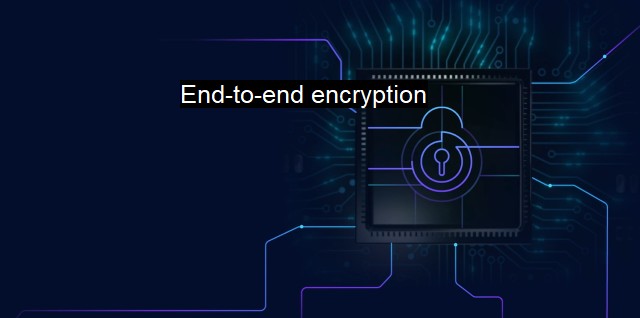What is End-to-end encryption?
Keeping Your Information Safe: The Power of End-to-End Encryption in Online Communication and Data Transfer
End-to-end encryption is a critical measure in cybersecurity that plays the role of securing communication channels in a manner that makes it impossible for anyone apart from the intended recipient to access the transmitted information. It relates to the protection of data against unauthorized access while it's in transit, and even when it sits idle on the devices from which it was sent.This encryption concept is an essential attribute for appropriate cybersecurity measures, contributing to the defenses developed by antivirus tools. end-to-end encryption helps to secure your devices and protect your digital way of life.
One might wonder how this feature operates. A basic understanding begins with the realization that end-to-end encryption converts transmitted information into codes that can only be unlocked by those associated with correct deciphering keys, i.e., the sender and specifier receiver. The term "end-to-end" implies that this encryption process comes into effect distinctly at each endpoint of a communication channel. Consequently, intercepted information will remain unreadable to unauthorized infiltrators, whose operations would usually thrive on plain and unencrypted data.
Significantly, the concept proves instrumental in providing information security for several technology-driven spaces, including personal and enterprise chats, emailing, voice-over IPs, VPNs, and more. It's the security aspect that protects messages on trending chatting platforms and enables secure transactions, ensuring confidential business emails aren't seen by competitors or hackers.
The practice’s durability forms due to a key sharing mechanism used to encrypt and decrypt the message. First, the sender’s device uses an encryption key to transform the readable message into a ciphertext. This scrambled message is then sent over to the recipient, who can only see the initial message when their device applies a decryption key. This decentralizing mechanism safeguards the encrypted message, ensuring that no middle-man can decode the stored or transferred data.
In terms of antivirus software development, end-to-end encryption ranges from protection against digital threats of access to unauthorized data interception to prevention of malicious espionage activities. the sneaky and often performing unwelcome modifications come with a weakness to end-to-end encryption. Thanks to this technology, encrypted files affected by viruses will not disclose any meaningful information to the attacker as they remain unreadable without the proper deciphering keys.
Due to growing cyber-attacks, end-to-end encryption’s importance mustn't be underrated. Its benefits are inevitable in securing sensitive information in several sectors, including finance, healthcare, and even social media. It also increased trust among users, knowing that personal conversations, financial transactions, or business strategies aren't accessible to anyone else.
Despite being a powerful instrument of cybersecurity, end-to-end encryption is also a subject of ongoing debates. Some stakeholders raise concerns that encryption technology offers a safe haven for perpetrators to conduct illegal activities. Governments and security agencies argue for backdoors to the encryption systems for matters of national security. cybersecurity experts resist these endeavors asserting that these “backdoors” would potentially be exploitable by malicious hackers.
End-to-end encryption serves a pivotal role safeguarding information from being understood if intercepted by an unauthorized party. Whether it's in the realm of secure, personal chats, preventing unauthorized data access in antivirus tools, or facilitating business communications, end-to-end encryption acts as a bulwark against unwarranted access to information. While debates persist surrounding its regulation, its value in the current digital age is undeniable, forming critical infrastructure in security technologies.

End-to-end encryption FAQs
What is end-to-end encryption?
End-to-end encryption is a type of data encryption where only the sender and receiver have access to the plaintext during transmission. This means that no third-party, including service providers or hackers, can access the data in transit.Why is end-to-end encryption important for cybersecurity?
End-to-end encryption is important for cybersecurity because it prevents unauthorized access to sensitive information during transmission. This ensures that the data remains confidential and secure, protecting it from cyber threats like hacking and data breaches.How does end-to-end encryption differ from standard encryption?
Unlike standard encryption, which only encrypts the data during transmission, end-to-end encryption encrypts the data at both the sender and receiver's ends, making it virtually impossible for unauthorized users to access the data. Additionally, it ensures the security of the data even if the data is intercepted by an attacker.Do antivirus programs provide end-to-end encryption?
Antivirus programs do not provide end-to-end encryption. Their primary function is to detect and remove malware and other cyber threats on a user's system. While some antivirus programs may have encryption features, they are not designed to provide end-to-end encryption.| | A | | | B | | | C | | | D | | | E | | | F | | | G | | | H | | | I | | | J | | | K | | | L | | | M | |
| | N | | | O | | | P | | | Q | | | R | | | S | | | T | | | U | | | V | | | W | | | X | | | Y | | | Z | |
| | 1 | | | 2 | | | 3 | | | 4 | | | 7 | | | 8 | | |||||||